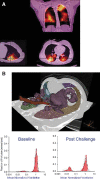Measuring Anatomical Distributions of Ventilation and Aerosol Deposition with PET-CT
- PMID: 37585546
- PMCID: PMC10623465
- DOI: 10.1089/jamp.2023.29086.jgv
Measuring Anatomical Distributions of Ventilation and Aerosol Deposition with PET-CT
Abstract
In disease, lung function and structure are heterogeneous, and aerosol transport and local deposition vary significantly among parts of the lung. Understanding such heterogeneity is relevant to aerosol medicine and for quantifying mucociliary clearance from different parts of the lung. In this chapter, we describe positron emission tomography (PET) imaging methods to quantitatively assess the deposition of aerosol and ventilation distribution within the lung. The anatomical information from computed tomography (CT) combined with the PET-deposition data allows estimates of airway surface concentration and peripheral tissue dosing in bronchoconstricted asthmatic subjects. A theoretical framework is formulated to quantify the effects of heterogeneous ventilation, uneven aerosol ventilation distribution in bifurcations, and varying escape from individual airways along a path of the airway tree. The framework is applied to imaging data from bronchoconstricted asthmatics to assess the contributions of these factors to the unevenness in lobar deposition. Results from this analysis show that the heterogeneity of ventilation contributes on average to more than one-third of the variability in interlobar deposition. Actual contribution of ventilation in individual lungs was variable and dependent on the breathing rate used by the subject during aerosol inhalation; the highest contribution was in patients breathing slowly. In subjects breathing faster, contribution of ventilation was reduced, with more expanded lobes showing lower deposition per unit ventilation than less expanded ones in these subjects. The lobar change in expansion measured from two static CT scans, which is commonly used as a surrogate for ventilation, did not correlate with aerosol deposition or with PET-measured ventilation. This suggests that dynamic information is needed to provide proper estimates of ventilation for asthmatic subjects. We hope that the enhanced understanding of the causes of heterogeneity in airway and tissue dosing using the tools presented here will help to optimize therapeutic effectiveness of inhalation therapy while minimizing toxicity.
Keywords: aerosol deposition; anatomic distribution; bifurcation factor; escape fraction; heterogeneity; inhaled therapeutics; lobar deposition.
Conflict of interest statement
The author, employed by the Massachusetts General Hospital, Boston, Massachusetts, USA, received financial support from Air Liquide Santé International.
Figures
















References
-
- Venegas J, Winkler T, Harris RS. Lung physiology and aerosol deposition imaged with positron emission tomography. J Aerosol Med Pulm Drug Deliv 2013;26(1):1–8. - PubMed
-
- Brownell GL, Burnham CA, Chesler DA, et al. . PCR-I high resolution positron tomograph using analog coding. IEEE Trans Med Imaging 1984;3(1):10–17. - PubMed
-
- Walters TE, Simon W, Chesler DA, et al. . Attenuation correction in gamma emission computed tomography. J Comput Assist Tomogr 1981;5(1):89–94. - PubMed
-
- Green M V, Seidel J, Vaquero JJ, et al. . High resolution PET, SPECT and projection imaging in small animals. Comput Med Imaging Graph 2001;25(2):79–86. - PubMed
-
- Musch G, Layfield JDH, Harris RS, et al. . Topographical distribution of pulmonary perfusion and ventilation, assessed by PET in supine and prone humans. J Appl Physiol 2002;93(5):1841–1851. - PubMed
Publication types
MeSH terms
Grants and funding
LinkOut - more resources
Full Text Sources
Medical

